Vindobona (Vienna)
Q871525Vindobona: Roman military base and town in Pannonia Superior (modern Wien, English Vienna).

The story of Roman Vienna, or - to use its ancient name - Vindobona, starts somewhere in the Rhineland, where the Roman general Marcus Lollius suffered a defeat by the hands of the Germanic Sugambri in 17 or 16 BCE. It was not a disaster, but the Roman emperor Augustus decided that the Germanic problem had to be solved once and for all. As a first move, his two stepsons Drusus and Tiberius conquered the old Celtic states north of the Alps: Vindelicia, Raetia, the kingdom of Noricum, and finally Pannonia in 9 BCE. Many defeated tribes are mentioned on the victory monument at La Turbie. A last Pannonian revolt in 6 CE lasted for three years, but finally, the Romans overcame all opposition. For more than a four centuries, the Danube was to be the northern frontier of the Roman Empire.
Originally, Vindobona was an oppidum (proto-urban settlement) on the Leopoldsberg, just north of what is now the center of modern Vienna. It belonged to the Celtic kingdom of Noricum, but the emperor Augustus (or, more correctly, his general Tiberius) added the oppidum to Pannonia, which became a formal province during the second half of the reign of Claudius (r.41-54).
It is at this stage that a subunit of the Fifteenth Legion Apollinaris, which was stationed at Carnuntum, was sent to Vindobona. Occupation was necessary because Pannonia is essentially open land without obstacles to an enemy coming from the north or east. The construction of a line of strong forts and fortresses was imnperative.
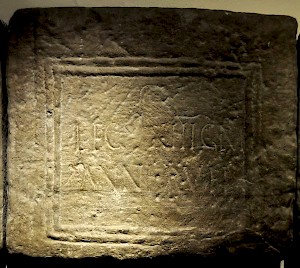
The site of the first Roman fort has not been identified yet, but it must have been closer to the center of modern Vienna than to the Leopoldsberg. (It is tempting to assume that it was on the site of the medieval castle, the Hofburg, which was to become the residence of the Habsburg grand dukes and emperors.) The first military settlement must have been constructed out of wood, like all forts in this period. During the second half of the first century, it was occupied by several mounted auxiliary units, like an Ala I milliaria from recently conquered Britain. The possibility that there was more than one fort in the area of modern Vienna cannot be excluded.
Late in the first century, probably in 89, the emperor Domitian transferred the Thirteenth legion Gemina from Poetovio (modern Ptuj in Slovenia) to Vindobona. War had broken out on the Lower Danube, and Rome needed additional forces in Pannonia to fight against the Dacians and their allies. The soldiers of the Thirteenth constructed the legionary base that was to become the center of what is still called Vienna.
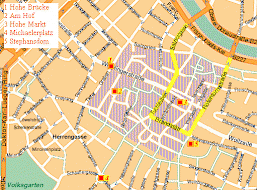
The site chosen was because at this point, the Amber road (from the Baltic to the Adriatic Sea) crossed the Danube, which in those days had its course more or less through the present Donaukanal. The street now known as Kohlmarkt follows the course of the ancient road that must have been used by the amber merchants going south. The legionary base was built at a terrace, which in the north faced the river Danube and in the east a brook that is more or less on the site of the modern Rotenturmstraße. To the south was a wide ditch that is still called the Graben. In the west, the Tiefer Graben ("deep moat") follows the course of another ancient brook. In the center, the modern Wipplingerstraße and Wollzeile follow the course of the limes road that once continued along the Danube.
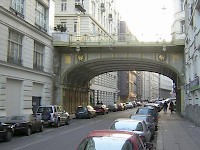
Several elements of the ancient fortress, which had a size of about 18½ hectare, can still be recognized on the modern map. There is a bridge, the Hohe Brücke, on the site of the crossing of the Wipplingerstraße and the western moat (map #1). The westernmost part of modern Hohe Markt ("Upper Market"; map #3) is more or less identical to the forum. Parts of the houses of legionary officers have been excavated in the same area. Another excavation was on the square called Am Hof (map #2). Remains of the civil settlement (vicus) have come to light at the Michaelerplatz (map #4) at the main entrance of the Hofburg to the south of the fortress. The roads now known as Herrengasse and Augustinerstraße also have ancient predecessors: this was the shortcut for people arriving from the northwest and traveling to the south without intention to visit the military settlement. Along the Herrengasse must have been a cemetery
The natives were quickly romanized. The settlement at the Leopoldsberg had been abandoned when the Thirteenth legion Gemina had started to build its base.
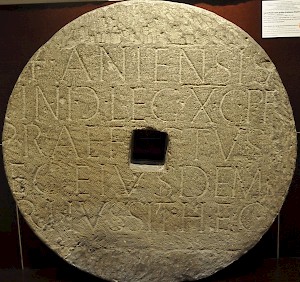
In 92, the Romans suffered a disastrous defeat when one of their legions, XXI Rapax was destroyed by the Dacians. Immediately, XIV Gemina was transferred from Mainz to Pannonia, and after a brief stay at Osijek, it was sent to Vindobona, which served as its base when it fought against the Suebes and Sarmatians. The Thirteenth, which had until then inhabited the legionary base, was sent to Apulum in Dacia (modern Alba Julia).
The wars on the Danube continued during the reigns of Nerva and Trajan and culminated in the conquest of what is now called Romania (in 106). The military units were reshuffled again, and the Fourteenth, which had arrived in Vindobona only a couple of years before, was transferred to Carnuntum in 114. It was replaced by the Tenth legion Gemina, from Noviomagus (Nijmegen in Holland). This unit was to stay in Vindobona for another three centuries.
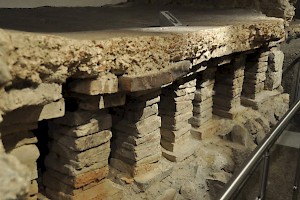
In these days, at the beginning of the second century, the walls of the fortress were reconstructed out of stone. They offered protection for about 6,000 legionaries, an unknown number of auxiliary troops, and their horses. The soldiers of Vindobona did not live in poverty: we know that there was a luxurious bathhouse. Water was brought to the fortress by an underground aqueduct, which had its sources near the modern villages of Perchtoldsdorf and Gumpoldskirchen, about 30 kilometers to the south. (There were several wells in this area; one of them, called Aquae, was known for its curative powers and is still a Kurort known as Baden.) The settlement itself boasted an excellent sewer system.
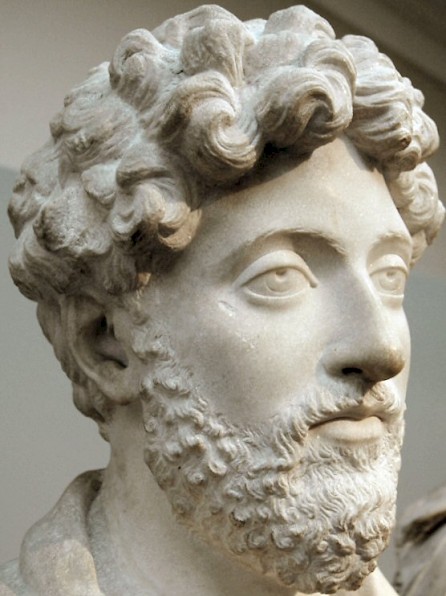
The stone walls did not protect the site when the Marcomanni, an important Germanic tribe living in Bohemia, invaded Pannonia in 166. They must have defeated the tenth legion, crossed the Alps, and - continuing along the Amber Road - reached the Adriatic Sea. A very large war broke out, which was to last until 180. During this conflict, Vindobona was sacked. The Roman emperor Marcus Aurelius, one of the greatest warriors of Antiquity, defended the Danube frontier and was able to seize the initiative. Vindobona was rebuilt and seems to have offered accommodation to the headquarters of the imperial forces.
Marcus Aurelius died on 17 March 180, when the Romans had conquered their enemies. According to the Roman author Aurelius Victor, the emperor died in Vindobona. (Vienna's Mark-Aurelstraße cannot be far from the ancient praetorium, where the ruler died.) His son and successor Commodus concluded a peace treaty with the Marcomanni. Marcus Aurelius' plans to create provinces north of the Danube, were ignored; perhaps wisely, because there were no troubles in this area for a long time. The Marcomanni had learned their lesson.
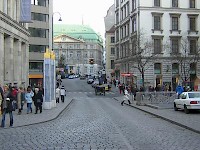
In the first half of the third century, Vindobona was rebuilt again. This was the beginning of the settlement's golden age, which continued after 260, when the Germanic tribes became aggressive again. The fortress was an important bulwark against the northern enemies, and the imperial forces were reinforced; the soldiers could spend their money in the civil settlement. By now, about 20,000 people were living near the fortress. Most of them must have belonged to the native population, but veterans were a substantial element too. The soldiers had arrived from all parts of the Roman empire (one inscription mentions Carthaginians).
The city was well-integrated in the Roman empire. The people must have spoken Latin, and many Mediterranean deities are known to have been venerated: not only the gods of the Roman state (like Jupiter, Juno, and Minerva), but also the Greek Apollo, the Celtic Grannus, the oriental Mithras, and the Egyptian Isis and Serapis. The Roman taste for gladiatorial combat reached Vindobona too: there was a naumachia (for fights between ships) at the confluence of the rivers Wien and Danube.
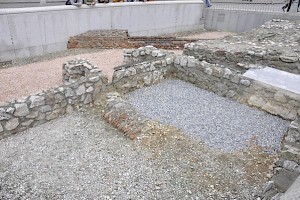
In ca.395, Vindobona was sacked again by Germanic warriors of the Marcomannic tribe, and again, the civil and the military settlement were rebuilt, although probably on a smaller scale. In the first decade of the fifth century, a fire destroyed the fortress. The Hohe Markt excavations show that the legionary base, which was still used by soldiers of the Tenth legion Gemina, was now less densely populated than before, because the new buildings have a different orientation, which proves that the old gridiron-map had been abandoned. The settlement now also boasted a naval base for the Classis Histrica.
By this time, Vindobona had become a Christian city. It is not clear whether the current church of Saint Peter is on the site of an ancient shrine.
Alans and Ostrogoths gradually infiltrated the civil settlement, and the soldiers of the fortress were often recruited from these tribes. In 433, the East-Roman emperor Theodosius II allowed the Huns to occupy Vindobona. (According to the Nibelungenlied, king Etzel [=Attila] married Kriemhild in Vindobona.) At the beginning of the sixth century, Pannonia and the city of Vindobona were taken over by the Langobards, and later - in 568, to be precise - by the Avars, who were ultimately defeated by Charlemagne.